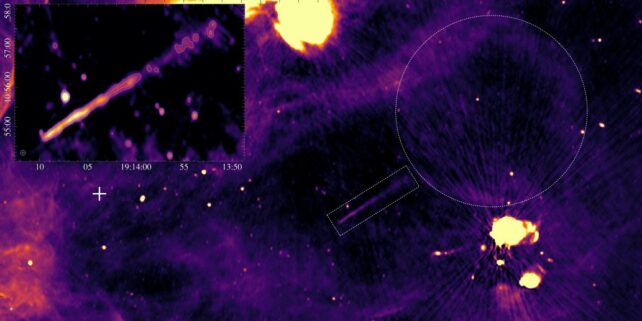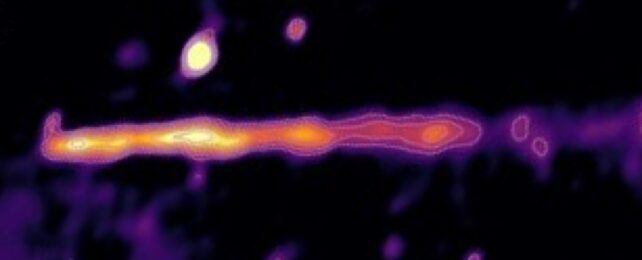Astronomers studying black holes have serendipitously found another rarity: A dead star rocketing away from its birth supernova, leaving a comet-like trail of radio emission in its wake.
Named PSR J1914+1054g, the star is just the fourth known of its kind: a radio pulsar kicked at high velocity across space, for which astronomers have observed not just the pulsar but the trail behind it known as a bow-shock nebula, and the supernova remnant from which it was kicked.
A team of scientists led by astrophysicist Sara Elisa Motta of the Brera Astronomical Observatory in Italy and the University of Oxford in the UK has named the nebula Mini Mouse.
The death of a massive star is a pretty violent affair. When they run out of fuel, the fusion supplying the outward pressure that supports the star against the inward pressure of gravity suddenly drops off, and things get messy.
The star goes boom, spewing its guts everywhere, while the core collapses under gravity into an ultradense neutron star up to 2.16 times the mass of the Sun, packed into a sphere just 20 kilometers (12 miles) across.
In many cases, these stellar remnants can be found sitting ensconced in the nebula created by their exploded remains. But if the supernova explosion is lopsided, the uneven energy distribution can meet the neutron star across space at high speeds, zooming across the galaxy.
But a special set of circumstances is required to produce a nebula like the Mini Mouse.
First, the neutron star has to be a pulsar – one that is rotating at high speeds, so named because it "pulses" like a cosmic lighthouse as beams of radiation shoot from its poles, guided and accelerated by powerful magnetic fields.
Those magnetic fields also accelerate charged particles into a furious wind that whips around the pulsar, sometimes interacting with the surrounding interstellar medium to generate a pulsar wind nebula.
But if that pulsar receives a natal kick by an uneven supernova, a bow shock forms in the direction of travel, redirecting and channeling the pulsar wind behind the pulsar, like the tail of a comet. This is known as a pulsar bow-shock nebula, visible as a glow of light.
Motta and her colleagues were using the MeerKAT radio telescope in South Africa to study a binary star named GRS 1915+105. Consisting of a black hole and a normal star, they noticed something peculiar about this binary star: a smear of light streaking across their field of view looking startlingly similar to a pulsar bow-shock nebula discovered in 1987 called the Mouse.

A search through data collected by the ongoing FAST Galactic Plane Pulsar Snapshot (GPPS) survey revealed a newly discovered pulsar with a spin period of 138 milliseconds that appeared to be positioned at the front of this streak. Follow-up observations conducted by the team revealed that J1914 is placed exactly at the head of the nebula.
The MeerKAT radio data also revealed a faint circular shape far behind the pulsar and its tail, with the trajectory seeming to trace right back to its center. This, the researchers identified as the remnant of the supernova that birthed the pulsar J1914.
The length of the tail, the team found, is around 40 light-years, and the radius of the supernova remnant is about 43 light-years. They also determined that it's been about 82,000 years since the pulsar was born (i.e., the supernova took place); tracing back towards the center of the nebula, that puts J1914's velocity at a supersonic 320 to 360 kilometers per second (200 to 225 miles per second).
That's far from the fastest runaway star we've ever seen, and it's not sufficient to achieve escape velocity from the Milky Way, but it is a pretty impressive clip. And, as the researchers noted, just three other pulsars have been identified with the same characteristics.
The discovery, the researchers said, will help astronomers better understand pulsars and their winds, supernova explosions, the local interstellar medium, high-speed particles, and wind-generated shocks. Moreover, it represents MeerKAT's potential in uncovering these heretofore rare-to-find objects.
"Thanks to the detection of structures similar to the Mouse and Mini Mouse," they write.
"MeerKAT will help unveiling more young radio pulsars which will add to the still small population of such objects, which is predicted to count thousands of members in our Galaxy."
The research has been accepted for publication in the Monthly Notices of the Royal Astronomical Society and is available on the preprint server arXiv.
